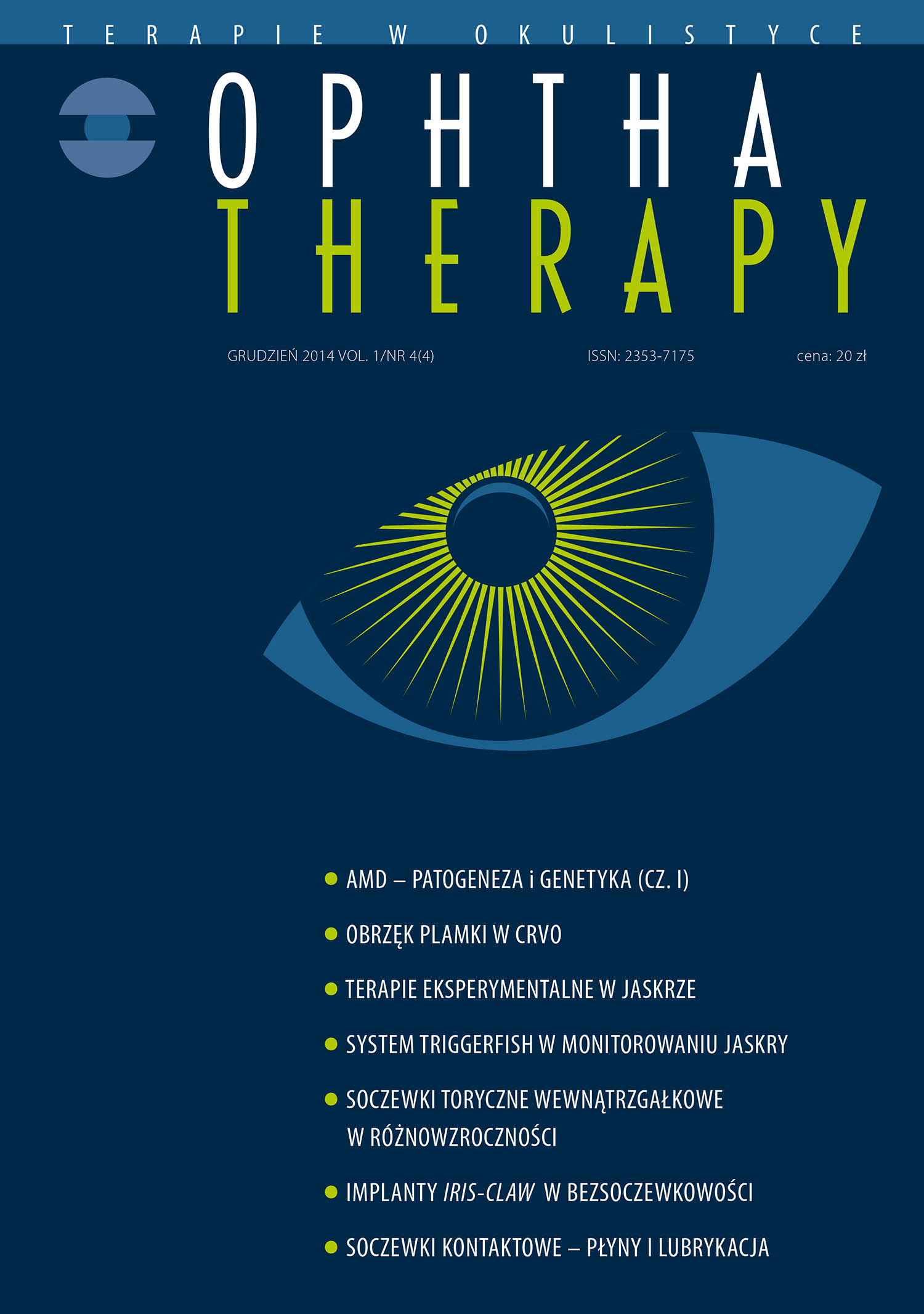Towards a better understanding of glaucomatous optic neuropathy. 24-hour continuous monitoring of changes in the eyeball dimension
Main Article Content
Abstract
Intraocular pressure (IOP) nowadays is the only treatable risk factor for glaucoma. Current glaucoma management typically relies on single IOP measurements during clinic hours despite the fact that IOP is a dynamic parameter with individual patterns. New technologies enabling 24-hour ocular biomechanical data collection may soon improve our glaucoma understanding and treatment. This article bringing clinical data about first commercially available 24-hour continuous eye-volume monitoring system Sensimed Triggerfish with all its advantages, weaknesses and it related hopes
Downloads
Article Details

This work is licensed under a Creative Commons Attribution-NonCommercial-NoDerivatives 4.0 International License.
Copyright: © Medical Education sp. z o.o. License allowing third parties to copy and redistribute the material in any medium or format and to remix, transform, and build upon the material, provided the original work is properly cited and states its license.
Address reprint requests to: Medical Education, Marcin Kuźma (marcin.kuzma@mededu.pl)
References
2. Weinreb RN. Intraocular Pressure. Kugler Publications, Amsterdam 2007.
3. Whitacre MM, Stein R. Sources of error with use of Goldmann-type tonometers. Surv Ophthal. 1993; 38: 1-30.
4. Ehlers N, Bramsen T, Sperling S. Applanation tonometry and central corneal thickness. Acta Ophthalmol (Copenh). 1975; 53: 34-43.
5. Liu J, Roberts CJ. Influence of corneal biomechanical properties on intraocular pressure measurement: quantitative analysis. J Cataract Refract Surg. 2005; 31: 146-55.
6. Liu JH, Kripke DF, Twa MD. Twenty-fourhour pattern of intraocular pressure in the aging population. Invest Ophthalmol Vis Sci. 1999; 40: 2912-7.
7. Liu JH, Zhang X. Twenty four-hour intraocular pressure pattern associated with early glaucomatous changes. Invest Ophthalmol Vis Sci. 2003; 44: 1586-90.
8. Barkana Y, Anis S, Liebman J et al. Clinical utility of intraocular pressure monitoring outside of normal office hours in patients with glaucoma. Arch Ophthalmol. 2006; 124: 793-7.
9. Mosaed S, Liu JH, Weinreb RN. Correlation between office and peak nocturnal intraocular pressures in healthy subjects and glaucoma patients. Am J Ophthalmol. 2005; 139: 320-4.
10. Hattenhauer MG, Johnson DH, Ing HH et al. The probability of blindness from open-angle glaucoma. Ophthalmology. 1998; 105: 2099-104.
11. Liu JH, Weinreb RN. Monitoring intraocular pressure for 24 h. Br J Ophthalmol. 2011; 95: 599-600.
12. Wasilewicz RH, Wasilewicz PK, Mazurek C et al. Daily biorhythms of ocular volume changes and the cardiovascular system functional parameters in healthy, ocular hypertension, normal tension and primary open angle glaucoma populations. EVER 2014 (prezentacja ustna)/ARVO 2014 (plakat).
13. Weinreb RN, Liu JH. Nocturnal rhythms of intraocular pressure. Arch Ophthalmol. 2006; 124: 269-70.
14. Mansouri K, Orguel S, Mermoud A et al. Quality of diurnal intraocular pressure control in primary open angle patients treated with latanoprost compared with surgically treated glaucoma patients: a prospective trial. Br J Ophthalmol. 2008; 92: 332-6.
15. Caprioli J, Varma R. Intraocular pressure: modulation as treatment for glaucoma. Am J Ophthalmol. 2011; 152: 340-4e2.
16. Leonardi M, Pitchon EM, Bertsh A et al. Wireless contact lens sensor for intraocular pressure monitoring: assessment on enucleated pig eyes. Acta Ophthalmol. 2009; 87: 433-7.
17. Hjortdal JO, Jensen PK, Bertsh A et al. In vitro measurement of corneal strain, thickness, and curvature using digital image processing. Acta Ophthalmol Scand. 1995; 73: 5-11.
18. Leonardi M, Leuenberger P, Bertrand D et al. First steps toward noninvasive intraocular pressure monitoring with a sensing contact lens. Invest Ophthalmol Vis Sci. 2004; 45: 3113-7.
19. Mansouri K, Medeiros FA, Tafreshi A et al. Continuous 24-hour monitoring of intraocular pressure patterns with a contact lens sensor: safety, tolerability, and reproducibility in patients with glaucoma. Arch Ophthalmol. 2012; 130: 1534-9.
20. Freiberg FJ, Lindell J, Thederan LA et al. Corneal thickness after overnight wear of an intraocular pressure fluctuation contact lens sensor. Acta Ophthalmol. 2012; 90: e534-9.
21. Hubanova R, Aptel F, Chicqet C et al. Effect of overnight wear of the Triggerfish sensor on corneal thickness measured by Visante anterior segment optical coherence tomography. Acta Ophthalmol. 2013; 92: e119-3.
22. Realini T, Weinreb RN, Weinreb N. Short-term repeatability of diurnal intraocular pressure patterns in glaucomatous individuals. Ophthalmology. 2011; 118: 47-51.
23. Realini T, Weinreb RN, Wisniewski SR. Diurnal intraocular pressure patterns are not repeatable in the short term in healthy individuals. Ophthalmology. 2010; 117: 1700-4.
24. Mottet B, Aptel F, Romanet JP et al. 24-hour intraocular pressure rhythm in young healthy subjects evaluated with continuous monitoring using a contact lens sensor. JAMA Ophthalmol. 2013; 131: 1507-16.
25. Mansouri K, Liu JH, Weinreb RN et al. Analysis of continuous 24-hous intraocular pressure patterns in glaucoma. Invest Ophthalmol Vis Sci. 2012; 53: 8050-6.
26. Grippo TM, Liu JH, Zebardast N et al. Twenty-four-hour pattern of intraocular pressure in untreated patients with ocular hypertension. Invest Ophthalmol Vis Sci. 2013; 54: 512-7.
27. Wasilewicz RH, Stopa M, Rakowicz P. Tonografia oczna Triggerfish a ciśnienie wewnątrz komory ciała szklistego. Zjazd Okulistów Polskich, Warszawa 2011 (prezentacja ustna).

